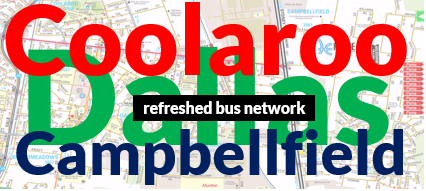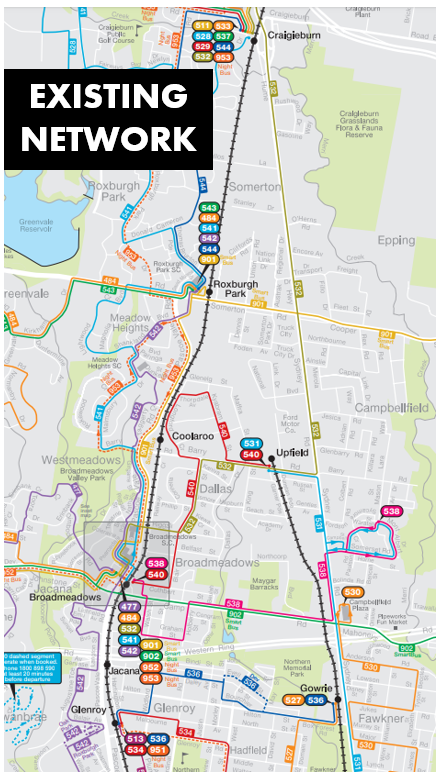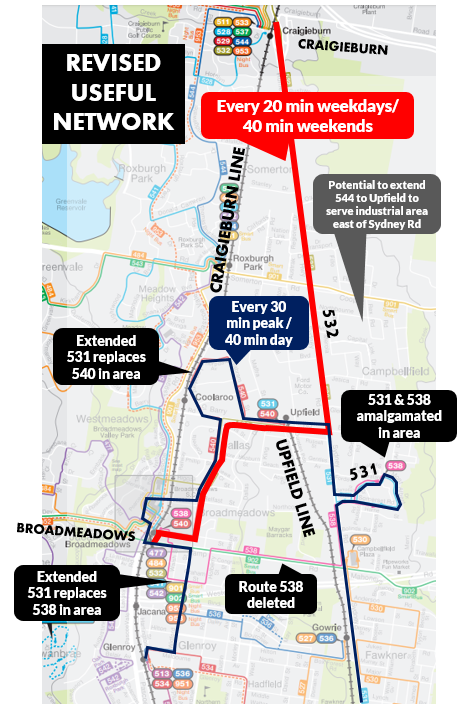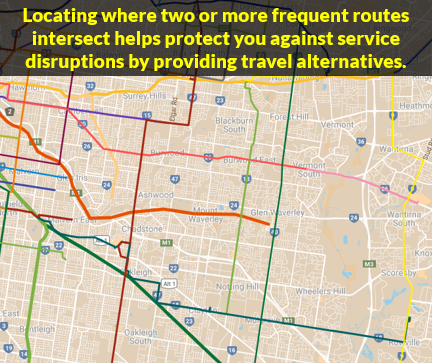Public transport was one of its measures. However it wasn't very useful in the way it was done.
For example there was a bias towards being near all three modes with no assessment of whether routes go to useful places, their frequency or reliability. Some suburbs can be large with parts distant from useful service so comments made for the centre of the suburb may not relate to its outskirts. While talking about suburbs makes easy media fodder, it's better to do what Walkscore and Transitscore do and allow lookups of specific addresses. And some results can be plain quirky, such as comments to the effect that East Melbourne was marked down for buses (it's a small suburb that has Melbourne's busiest bus corridor on its northern boundary).
1. Frequency is freedom
If you wish to really see what areas have the best public transport the best starting point is my
frequent network maps. Depending on the quality of service you are after you can choose between every 10, every 15 and every 20 minutes. High frequencies provide the best flexibility if your travel plans change and enable connectivity if your trip needs a change, such as between train and bus.
Use menu buttons to switch between frequencies and which modes you wish to show (start with train, tram and bus). Clicking on individual routes gives further information such as frequencies by day. Maps are available for weekdays, Saturdays and Sundays. If you value 7 day frequent service then use the Sunday map; weekdays and Saturdays will be better (with very few exceptions like trains past Ringwood).
As a rough guide, trams offer frequent service over long hours, trains semi-frequent service over long hours and buses varying service over shorter hours. V/Line trains have quite good operating hours but limited frequency. If you really value transit access locate near the junction of several frequent and semi-frequent routes so that good service is available in multiple directions. This greatly increases the range of trips convenient by public transport.
2. Check the after 10pm map
Trains and trams operate until midnight but most bus routes finish around 9pm or earlier. Especially on Sundays when only a few are still running at 10pm. See my after 10pm maps for what part of the network runs then and check the frequencies available if service at these times is important.
If you're a night owl locate on one of the six Night Network tram routes that offer a 24 hour weekend service. Being near a Metro train station is the second-best option though as Night Network trains run only hourly. Night Network buses run in some areas but operating hours vary and routes may change (given some are quite poorly used).
3. Consider walkability
Station car parks can fill up early. Buses aren't always frequent or well-connected. So there's much to be said for being able to walk to a station.
Also consider walking access to shops and other services you'll be frequently using. It helps greatly if you are in an area where facilities (even those like letter boxes and ATMs) are clustered around transport interchanges rather than dispersed. This allows you to efficiently do a lot on foot and public transport with minimal waiting and interchanging. Suburbs established before WWII are the best for this. Newer ones, including those nominally with town centres clustered around stations such as Williams Landing, aren't as good as human scale access plays second fiddle to car circulation and parking. Older areas, ranked as our most prestigious, liveable and walkable suburbs, would not be allowed to have been built today due to current restrictive minimum parking and road design rules.
Just because something is close as the crow flies does not mean that it is walkable. Street patterns can restrict easy access. As can busy road that lack closely spaced signalised crossings.
Large roundabouts are bad news for pedestrians. If a roundabout has to be large it means there must be a wide road with lots of traffic. If there is a lot of traffic it means there will be few gaps between cars to easily and safely cross. Avoid suburbs with large roundabouts if you intend to walk anywhere.
At the very least visit them during busy times to assess traffic volumes. And if it's an outer area that's not fully developed factor in increased traffic. Busy roundabouts do eventually get replaced with signals but you could be waiting years. Walking is the transport mode that receives least consideration from road construction authorities who live to maximise car traffic throughput and design infrastructure accordingly.
4. Wise up to train tricks
You might think that if you choose a house that's walking distance to a station you've got it made. Especially if your job is in or near the CBD.
However service frequency, speed, reliability and comfort vary across the network. Some of its quirks, like the
inconsistent patterns of the City Loop and transposals at Flinders St, trip people up.
Timetables are rigged against the west and north due to the historically busier lines (and
marginal seats) being in the south and east where the highest service levels generally remain. Short lines like Upfield aren't particularly frequent during peak periods, and in Alamein, Altona and Williamstown's case, operate at a lower frequency during peak than interpeak.
Low frequency means that if a train is cancelled it's a longer wait to the next one. It can also mean delays when you can't easily control your departure from work or arrival at the station from a connecting service.
Beware of moving beyond rail junctions, especially if you travel off-peak. Frequencies beyond junctions like Dandenong and Ringwood typically halve, with Belgrave and Lilydale down to a half-hourly off-peak service. Victoria enjoys Australia's highest regional train frequencies but Melbourne has a poorer record than Sydney and Perth on most of its suburban lines.
Some lines like Sunbury and Hurstbridge don't have junctions but terminate a lot of their trains part way along it. If you value consistently high frequency on those lines avoid moving further out than Watergardens and Greensborough. And avoid the 'Cinderella' Stony Point line. Anyone who hopes to use it for commuting is a masochist; the last train on all but a Friday leaves Frankston at an unsuitably early time and you will often be relying on local parallel buses.
Train services can look good on paper but may be crowded and/or unreliable. Disruptions can disproportionately affect parts of some lines. Particularly outer portions where single line sections limit the ability to recover from a disruptions. Trains may be turned back before they reach the end of the line, resulting in cancellations for those near the end. In other cases trains may be routed to bypass your station. Avoid single line sections if you want reliable trains.
More here. The less reliable lines have
Facebook groups where you can read commuters' tales of woe.
Not all stations on a line are equal. Some are served by express services while others are not. Expresses don't always save a lot of time but can add frequency which is nice. In some cases you are better off to move further out (where there are express trains and land is cheaper) than closer in where there are no express trains and/or morning services are more crowded when you board.
Another (admittedly minor) consideration is that it can be handy to live where trains can terminate. This may give you more trains where trains start from there. On the Frankston line this includes stations like Caulfield, Moorabbin and Mordialloc. When lines are disrupted and substitute buses are run you might be able to get express buses that end up being quicker than the train services they replace.
5. End to end travel time is more important than speed
Land prices fall with distance from the CBD. You get more land for a given budget the further out you go. If you grow things, raise animals or just want a country-ish life a move to a peri-urban location could seem attractive.
Especially if you're near a fast regional train line. Imagine! Seated, you're zooming past straphangers having to endure stops at little stations. You've travelled 30km in the time your work colleagues have barely gone 5km on the tram. Yes, your in-train commute might indeed be faster than others despite their proximity to town.
Insanely low fares for daily commuters are another benefit. Exurban, mostly high-income, train commuters may moan about the service but won't tell you about the lurks they get with myki pass. They pay a pittance per kilometre travelled with the taxpayer heavily subsidising their lifestyle choice. This compares with (often lower income) occasional travellers who get slugged for travel beyond Zone 2 due to much higher myki money fares (
see fares tables if you don't believe).
Then there's V/Line train travel within Zone 2. V/Line is now predominantly a commuter network serving huge growing populations in Melbourne's north and west that lack an electrified (Metro) service. Example stations include Caroline Springs, Wyndham Vale and Tarneit.
If regional or peri-urban living and commuting is your thing consider a few other things before signing on the dotted line.
Regional trains are great if you happen to work near Southern Cross Station. Otherwise your commute may have complications. As much time could be spent waiting or on connecting services as on your 'fast' regional train service. Regional trains perform well for in-train travel but waiting can blow out overall travel time. And its the latter that's most important.
The limited versatility of the City Loop then really becomes apparent; for example did you know that one can't get direct trains to Southern Cross or Flinders Street from Flagstaff, Melbourne Central or Parliament in the afternoons? Also V/Line stopping patterns can be unhelpful for certain trips, for example Bendigo trains don't stop at Sunshine while Ballarat trains do.
Things can get complicated if you have to stay back or have an after-work function. Delays due to disruptions can be serious as, unlike in middle suburbs, you probably can't get a train on another line and a bus across. Taxi fares are super-expensive and, since you live so far out, there is less likely to be a work colleague who could drop you home.
Though not current,
these maps from Esri Australia can be helpful if you work near Flinders St Station.
Yes, the fares might be cheap. But is the extra time of peri-urban living in commuting and (potentially) looking after an acreage or small farm worth it? It is for some but not for others who, after a few years, sell up and move back into town.
6. Eschew the slow tram
Trams excel for their frequency compared to other modes. Except on Sundays they are never less frequent than every 20 minutes (versus 30 or 40 minutes for trains). However most of our trams run on roads shared with cars and are amongst the world's slowest. Route 75 is not much less than 90 minutes in the morning peak from Vermont South to Docklands, for example. Most cyclist commuters live near trams but save time riding.
Unless you travel when few others do a location near the end of a tram line might give you an hour commute - similar to that experienced by those double the distance away. You might get a seat on the way in but possibly not on the way home. Check
local area maps; sometimes you can speed travel by changing to a train part way along your tram route.
7. Beware the infrequent bus
The online map you use may have a little bus symbol right near where you're planning to buy. But don't assume it's a useful service. The typical outer suburban Melbourne bus runs approximately every 40 minutes until 9pm. Some outer areas have had decades with
even less service. New areas may get a bus but it's only a token service with one departure per day like
Route 511 to Mandalay Estate.
If public transport access is a priority your housing choice will probably need to be in an established area with developed services in several directions. Even then check timetables since there is little relationship between main road corridors that 'ought' to have frequent service and those that do. For example
parts of Nepean Hwy away from trains only gets hourly weekday buses and nothing on weekends (despite trams closer in being every 12 min). Weekday service is better on
Princes Hwy but weekend service is sparse. Other areas have better frequencies but buses routinely miss trains. This is widespread in north-east suburbs like Reservoir, Lalor, Rosanna and Greensborough where buses every 22 to 24 minutes miss trains every 20 minutes.
Melbourne peak bus service levels have generally been mediocre since big cuts in 1990/91. However good service survived on a few corridors, like Buckley St Essendon. Areas like Doncaster now have quite a dense network of frequent buses, at least on weekdays. And there's fast travel to the CBD via the Eastern Freeway. Check
evening and weekend timetables though as bus service typically falls off faster than train and tram service at these times.
8. Avoid dependence on one route or line
Being on a rail line is good but can leave you vulnerable to disruptions if it's the only way home. Even the best rail systems have to be occasionally shut down for maintenance work. Buses will be planned though travel times will usually be longer. A regular route option might be quicker, but only if you're in an area where it's available.
Then there's unplanned disruptions, due to level crossing crashes, wire theft, or faults in the network's very fragile points and signals. Such disruptions can leave you stranded, or at best, waiting around for replacement buses (along with hundreds of others).
Aim to live where there are multiple transport options. In inner suburbs this might mean being close to both train and tram lines. In the 10 - 30km ring choose areas with good bus connections with trains on lines either side. Ideally this should be a direct and frequent long-hours service such as a SmartBus orbital. Failing that even a bus every 20 minutes, such as identified on the Frequent Network Map, is better than indefinite waits for rail replacement services.
Some places further out can be more accessible than those closer in. For example the Werribee area has two train lines: Werribee and Geelong. Buses operate on direct routes between the two at reasonable frequencies. Hence you have two lines available if you live in between.
In contrast Point Cook's feeder buses only run to the Werribee line. Sunbury is similarly isolated with the only non-train connections with the rest of the metropolitan area being the very infrequent 479 and 483 buses. Melton, Pakenham and especially Geelong are also very vulnerable.
9. Don't believe promises
Developer ads might promise stations, trains and buses are coming soon to their estate. Don't believe them. They're not paying. The decision to build lines and run buses is wholly that of state government. Local governments and their mayors can do nothing but lobby.
Advocacy should not be confused with action. Services can lag development by 10 years or more. In some cases
promised lines or stations never get built. If you want transport only buy where it's already there or there's substantial evidence that it's under construction. Even then service quality can be an unknown quantity as the existence of a line or station does not guarantee a frequent service.
10. Do your research!
No one else will do it for you. Check maps to see if there are convenient routes near where you wish to settle. See that their timetables are adequate. Not just commuting times but earlier, later and on weekends. Some timetables have quirks that mean they lack service at times you'd expect them to operate. Also try commutes yourself to check crowding and reliability before making a decision.
Have more transport tips for home-makers? Why not leave them in the comments below?






































